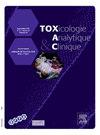From Lab to action: The role of a General Hospital Toxicology Lab in multidisciplinary responses to Flakka's regional emergence
IF 1.7
Q4 TOXICOLOGY
引用次数: 0
Abstract
In November 2022 an intoxicated patient was admitted to the AZ Delta General Hospital emergency department declaring he smoked Flakka. Initially appearing as an isolated case, it quickly became clear that this was the beginning of a regional emergence. In the following weeks, several patients presented with symptoms ranging from excited delirium syndrome and psychosis to coma, all linked to the use of Flakka. This surge necessitated a coordinated response at multiple levels: hospital, regional, and national.
To address this, our toxicology lab rapidly developed an LC-MS/MS method to selectively detect the cathinones alpha-PVP, alpha-PHP and alpha-PHiP in urine and implemented in the routine tox screening. To date, this method has been used to identify over 100 alpha-PHiP positive patients and enabled correct monitoring of the situation.
In parallel, actions were initiated along multiple axes. In the hospital, close cooperation with e.g. the emergency department led to effective follow-up and the initiation of patient management plans.
On a regional level, regular consultations were established with local stakeholders: the city council, law enforcement and healthcare providers. The focus here was on ensuring the exchange of accurate and up-to-date information on the issue, as well as streamlining external communication.
The toxicology lab's findings were continuously reported to Belgian Early Warning System (BEWSD). This ensured that the data collected at the regional level induced national responses.
One and a half years after the first case, our laboratory results indicate that alpha-PHiP has disappeared from the regional drug market. Interdisciplinary collaboration and rapid, open communication have proven to be crucial in tackling and containing this surge. However, continued monitoring of the (regional) drug market for potential successors to alpha-PHiP remains essential. While the toxicology lab plays a key role in this effort, progress depends on the activation of a multidisciplinary network.
从实验室到行动:综合医院毒理学实验室在多学科应对弗拉卡在地区出现中的作用
2022 年 11 月,亚利桑那州三角洲综合医院急诊科收治了一名醉酒病人,宣称他吸食了 Flakka。起初,这只是一个孤立的病例,但很快人们就发现,这是一个地区性毒瘾泛滥的开端。在接下来的几周里,多名患者出现了从兴奋性谵妄综合症、精神病到昏迷等症状,所有这些症状都与吸食 Flakka 有关。为解决这一问题,我们的毒理学实验室迅速开发出一种 LC-MS/MS 方法,可选择性地检测尿液中的α-PVP、α-PHP 和α-PHiP 等卡西酮,并将其应用于常规毒物筛查。迄今为止,该方法已用于确定 100 多名 alpha-PHiP 阳性患者,并对情况进行了正确监测。在医院,与急诊科等部门的密切合作促成了有效的后续行动,并启动了患者管理计划。在地区层面,与当地利益相关者(市议会、执法部门和医疗服务提供者)进行了定期磋商。这里的重点是确保交流有关这一问题的准确和最新信息,以及简化外部沟通。毒理学实验室的研究结果不断报告给比利时预警系统(BEWSD)。这确保了在地区层面收集的数据能够促进国家层面的应对措施。在第一例病例发生一年半后,我们的实验室结果表明,α-PHiP 已从地区毒品市场上消失。事实证明,跨学科合作和快速、公开的沟通对于应对和遏制这一疫情激增至关重要。不过,继续监控(地区)毒品市场以发现甲型六氢大麻酚的潜在后继者仍然至关重要。虽然毒理学实验室在这项工作中发挥着关键作用,但进展取决于多学科网络的启动。
本文章由计算机程序翻译,如有差异,请以英文原文为准。
求助全文
约1分钟内获得全文
求助全文

 求助内容:
求助内容: 应助结果提醒方式:
应助结果提醒方式:


